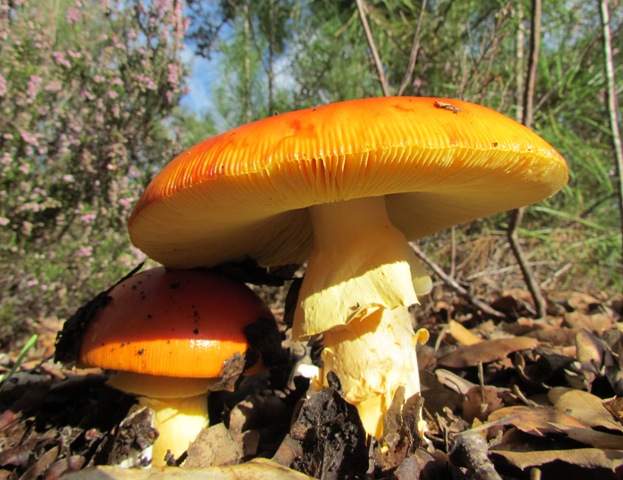At One with Nature - August Company
Fungal communism sorts the workers from the wasters, says Sue Parker
Based on an article by Sue Parker in Algarve Resident, August 2016. Algarve Resident is the leading English-language newspaper and the source of essential information for Residents and would-be Residents in the Algarve.
For more information about Algarve Resident...
Princely, fit for a king, imperial –these terms describe something auspicious or someone venerable – august even. And in the month of August it’s worth recalling the origin of that name, which dates from Roman times. In 8 B.C. the Senate honoured the first Roman emperor Augustus Caesar by changing the name of the month Sextilis to Augustus – now August in our calendar.

The Prince, a beautiful scaly-capped edible mushroom
Augustus, a great nephew of Julius Caesar, was born Gaius Octavius. It was he who, with Mark Anthony and Marcus Lepidus, formed the Second Triumvirate that avenged Caesar’s murder and became military dictators of the Roman Republic... until Augustus gained sole supremacy.
In the fungal kingdom Man has given regal names to several stately mushrooms. The Prince (an upper-class relative of that supermarket staple the button mushroom), King Bolete (an American name for Porcini or Cep) and Caesar’s Mushroom (the finest of the Amanita species) are three such examples. The Prince, despite its regal finery, seems rather aloof - or perhaps it is just shy. Shunning crowds, this aristocratic Agaricus is rarely seen far from the cover of conifers, usually solitary and often in shadows. Nevertheless the impressive stature and great garb of this beauty betray its presence to all but the least observant. These characteristics are encapsulated in the specific scientific name given to this fine edible mushroom: Agaricus augustus. The Prince is indeed august, but it is mere coincidence that in the high hills of the Algarve the first of these prized pickables appear in late August (rainfall permitting).

Caesar’s Mushroom Amanita caesarea is abundant in the Algarve’s wooded hillsides
Skipping a generation – the king, that is – let’s see what fungi those Roman emperors favoured. Top of their Mediterranean mushroom menu was a bright-orange beauty with a shiny domed head. Amanita caesarea was and still is (in name at least) the Mushroom of the Caesars. Although not generally seen in crowds, this is a friendly fungus, and in particular it is a friend of the forest. Trees love Caesar’s Mushroom so much that they even share their hard-earned sugar rations with it. In exchange these imperial benefactors provide the trees with water and other earth-borne nutrients. Amanita caesarea is, therefore, mycorrhizal – fungus and root system linked in a mutually beneficial relationship – a form of communism that actually works.
In the kingdom of fungi, as in the world of wildflowers, bright orange is not a particularly common colour. With its large orange cap, orange gills, and an orange stem wearing a flamboyant skirt-like orange ring, you could be forgiven for thinking that Caesar’s Mushroom is so distinctive as to be ‘perfectly safe’ to pick for the pot. Where fungi are concerned, nothing is perfect. No single feature is sufficiently consistent and distinctive to confirm an identity; every characteristic must be checked, especially habitat and lifestyle. Caesar’s Mushroom grows from soil beneath its partner tree, but never on the wood of the tree. Very similar, but much less delectable, is the Spectacular Rustgill, a bitter-tasting toadstool that feeds always on dead wood – it’s a rotter, therefore. The scientific name is Gymnopilus junonius, and it has a shiny domed orange cap, orange gills and stem, and a flamboyant skirt-like orange ring. Thus we have two very similar mushrooms, but they are readily distinguished by their different lifestyles.

Spectacular Rustgills Gymnopilus junonius. These wood-rotting toadstools could be confused with Caesar’s Mushrooms; some specimens have been reported to contain the hallucinogenic toxin Psilocybin.
When cooked, most mushrooms lose any distinctive colouring and turn greyish; this makes it easy to smuggle a toxic toadstool into meal. Rumours of murder by poisoning colour the chronicles of royals, nobles and religious notaries. Like modern conspiracy theories, the evidence is usually scant at best... but with murder by mushrooms that is hardly surprising.
Some historians believe that Pope Clement VII (1478 - 1534) was topped by toadstools, when his favourite fungi fare of Amanita caesarea was accidentally contaminated with a Deathcap Amanita phalloides. Rather more flaky is the evidence for mighty monarchs murdered by mushrooms, but such a fate has been suggested not only for the emperor Claudius (whose wife Agrippina may have been involved in a plot to poison the pot) but even that august first emperor of Rome, Augustus. If there is any substance in these rumours, the beautiful Caesar’s mushroom Amanita caesarea is blameless, and a pretender must have been involved.
There have been countless confirmed cases of death from fungi poisoning, but nearly all of them were accidents that could have been avoided by a more diligent ‘look before you cook’ approach. The occasional meal of ‘food for free’ is one of Life’s special treats, but at the start of the Algarve’s extended fungi fruiting season – late August until late April most years - it is worth reiterating that checking not only a mushroom’s appearance but also its lifestyle could help us maintain our own!
Back to articles...

